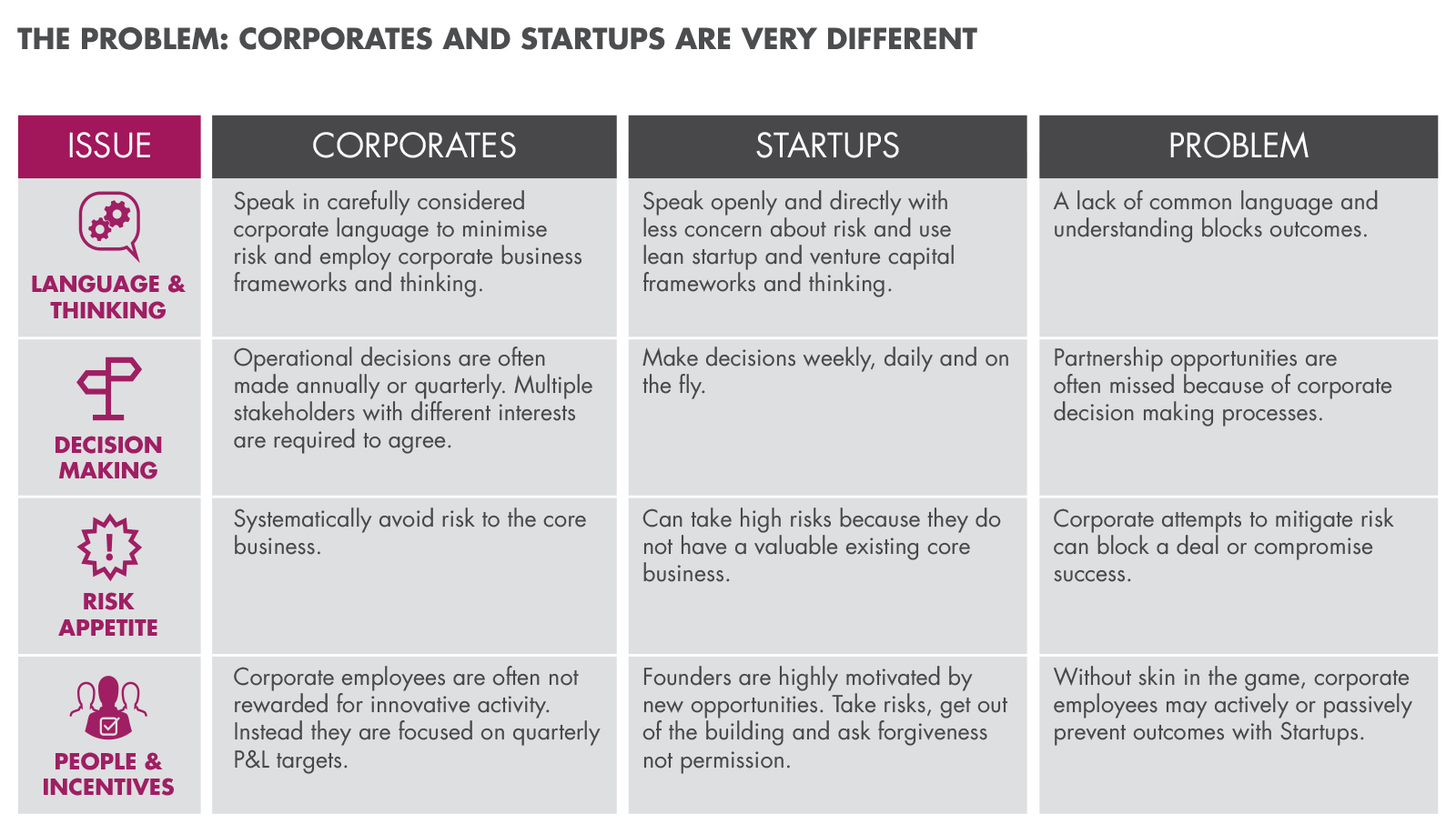How to solve Startup & Corporate engagement problems

Why is it so hard to achieve innovative outcomes with Startups in a corporate environment? How do you bring a large corporate and a small Startup together to create value?
When it comes to bridging the gap between large corporates and Startups, Slingshot are at the coalface. We’ve run corporate accelerator programs for the NRMA, HCF, ING Direct & Simplot and have worked with over 50 Startups to help them engage with our corporate partners.
However, it is not easy. In this article I share some of the lessons learned along the way, discuss some specific problems we’ve encountered and outline some of the solutions we’ve found.
Benefits and value of working together
By working with Startups, a large corporate gets access to a whole ecosystem of innovation. They can crowd-source ideas, get insight into innovative trends and access to high growth investment options.
As for Startups, they get access to the two things they need the most; customers and capital. They also get the validation that comes from working with a large corporate partner.
The problem(s)
The problems are many and varied but stem from the fact that that Startups and corporates are extremely different organisations at opposite ends of the business life cycle. Corporates have tens of thousands of employees and Startups have three. Corporates generally have a large operation with highly specialised employees, whereas Startup founders have to be generalists and cover a variety of roles.
Here’s how these differences play out across four important areas. I’ve chosen these areas because when trying to bring corporates and Startups together, they come up time and time again. The common theme is that they create barriers to achieving outcomes.

Solutions
Here are the solutions that we’ve come up with to overcome these problems and achieve commercial deals and investment outcomes for our corporate clients and Startup businesses.
Language and Thinking – Lean Canvas
A great starting point to create a common understanding and bring people together is a framework created by Ash Maurya called the Lean Canvas. Ash is a Slingshot Mentor and is personally involved in every program we run. Creating a Lean Canvas is a simple process that involves identifying a specific customer segment, understanding their problems, defining a unique value proposition and ensuring that a business model can be wrapped around it all.
Simple but not easy, as it involves speaking to customers and generating insight. However, that’s the solution we’ve found works best. Expose relevant corporate staff to the Lean Canvas method and teach them how to use this powerful framework. The feedback is always positive and it goes a long way to creating a common understanding.
We also invest time with Startups to help them understand corporate thinking and processes, but by far the best outcomes are achieved by having corporates think more like Startups not the other way around. After all, the world probably doesn’t need more corporate thinking.
Decision Making – Minimum Success Criteria & Key Metrics
Decision making is a crucial area if you’re trying to achieve outcomes and a point of failure if you don’t get it right. A method we’ve had success with is to apply a minimum success criteria (MSC) to decision making.
A MSC (another of Ash Maurya’s concepts) forces people to think of the lowest level of achievement for a project that they would still count as a success. This is not as easy as it sounds and the process can be challenging for participants.
The reality is that a MSC is very different from business case thinking or Big Hairy Audacious Goal thinking. It’s crucial however, because it gives you something hard and concrete to anchor decision making to.
The next step is to build out the Key Metrics that will get you to your definition of success, then test them for validity. Which brings us to the next solution that helps to bridge the divide.
Risk – Experiments
We routinely teach experiment methods to Startup founders to save them from wasting years of their lives and investor capital building something that no-one wants. In a corporate environment, experiments also work really well to reduce risk and validate assumptions.
We’ve recently helped a corporate client save $15m through a simple two-week experiment that proved customers didn’t want the product that they were going to build.
To bring corporates and Startups together, you need to reduce risk and support decision making. Low cost, rapidly deployed experiments do this really well.
People – Engagement, Alignment & Buy-in
The most complex piece of a complicated puzzle. In order to build successful innovative products and businesses, we have had to overcome corporate inertia caused by misalignment of culture, incentives and agendas. One of the ways we have achieved this has been to create our own corporate engagement process.
To start, we explore the mutual objectives of a Startup and the relevant stakeholders in the corporate. Then we identify areas of alignment or misalignment. Then when moving towards a trial we deliberately identify obstacles and where possible avoid, or overcome them.
If we come across intractable misalignment we advise both parties to end the engagement quickly to minimise the time investment.
Even when it doesn’t result in an outcome, this process of engaging with Startups leads to internal insight for our corporate partners. What often follows is the modification of incentive structures and KPIs, leadership development and culture change. When this activity is continued for several cycles over two to three years, the insight and outcomes ultimately result in genuine corporate transformation.
Summary
The challenges involved in bringing Startups and corporates together for mutual benefit are complex and multi-faceted. However, they are not completely intractable and can be solved with perseverance, insight and the right methods. Solving these problems, creates significant commercial value. Corporates gain an edge on their existing operations, access revenue from new products and over time transform their businesses. Startups get immediate access to customers, funding and validation. The accelerator programs we run at Slingshot, enable both parties to achieve these outcomes faster, accelerating business development, saving years and creating competitive advantage.






